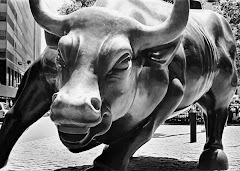The following is an excerpt of Fundsupermart.com analyst's view on US recession. This is a clear and present danger.
===========================
Recession Still Looks Likely For The US
The US economy grew an annualized 0.6% quarter on quarter in the first quarter of 2008, in line with economists’ consensus estimates. However, we could still see a recession unfolding, with the next two consecutive quarters registering negative GDP growth. First quarter GDP data can be subjected to revisions at a later date, and a downward revision could see the economy contracting in the first quarter instead.
Moreover, the “official” arbiter of whether or not we are in a recession is the National Bureau of Economic Research (NBER), which does not use the GDP numbers. The first quarter GDP growth was better than our expectations which bring us to make some revisions to our forecasts. In this article, we will also touch briefly on the US financial sector.
US Economy Grew 0.6% but Consumption Weakens Substantially
Domestic demand excluding inventories contracted for the first time since 1991. Positive economic growth was supported by the change in inventories and net exports. Consumer spending decelerated significantly, rising by only an annualized 1.0% quarter on quarter, the weakest performance since 2001. This softening was expected, in the context of falling employment, high inflation, restricted credit conditions, falling home prices, and wobbly equity markets.
The strong decline in consumer confidence (with the University of Michigan index hitting a 26-year low of 62.6 in April 2008) points to a further deterioration in the following quarter. The recently published preliminary confidence index for May on 16 May 2008 shows further deterioration.
During times of economic growth, the rising inventories actually signify the optimism of the businesses to build up their inventories in preparation for the increased demand. However, the current rise in inventories could be viewed as a lack of consumption by the consumers, such that inventories remain unsold and piles up. In the next few quarters, if consumption is expected to remain subdued, businesses would probably not be adding on to their inventories and there would be a good chance that the recession would take place even if it does not follow the definition of a technical recession.
===========================
Recession Still Looks Likely For The US
The US economy grew an annualized 0.6% quarter on quarter in the first quarter of 2008, in line with economists’ consensus estimates. However, we could still see a recession unfolding, with the next two consecutive quarters registering negative GDP growth. First quarter GDP data can be subjected to revisions at a later date, and a downward revision could see the economy contracting in the first quarter instead.
Moreover, the “official” arbiter of whether or not we are in a recession is the National Bureau of Economic Research (NBER), which does not use the GDP numbers. The first quarter GDP growth was better than our expectations which bring us to make some revisions to our forecasts. In this article, we will also touch briefly on the US financial sector.
US Economy Grew 0.6% but Consumption Weakens Substantially
Domestic demand excluding inventories contracted for the first time since 1991. Positive economic growth was supported by the change in inventories and net exports. Consumer spending decelerated significantly, rising by only an annualized 1.0% quarter on quarter, the weakest performance since 2001. This softening was expected, in the context of falling employment, high inflation, restricted credit conditions, falling home prices, and wobbly equity markets.
The strong decline in consumer confidence (with the University of Michigan index hitting a 26-year low of 62.6 in April 2008) points to a further deterioration in the following quarter. The recently published preliminary confidence index for May on 16 May 2008 shows further deterioration.
During times of economic growth, the rising inventories actually signify the optimism of the businesses to build up their inventories in preparation for the increased demand. However, the current rise in inventories could be viewed as a lack of consumption by the consumers, such that inventories remain unsold and piles up. In the next few quarters, if consumption is expected to remain subdued, businesses would probably not be adding on to their inventories and there would be a good chance that the recession would take place even if it does not follow the definition of a technical recession.
===================================
For full article, please check on Fundsupermart.com website.



